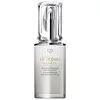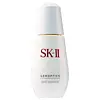What's inside
What's inside
 Key Ingredients
Key Ingredients

 Benefits
Benefits

 Concerns
Concerns

 Ingredients Side-by-side
Ingredients Side-by-side

Water
Skin ConditioningDipropylene Glycol
HumectantBetaine
HumectantAlcohol
AntimicrobialDimethicone
EmollientGlycerin
HumectantDiphenylsiloxy Phenyl Trimethicone
Skin ConditioningTriethylhexanoin
MaskingSilica
AbrasivePEG-5 Glyceryl Stearate
EmulsifyingPEG/PPG-14/7 Dimethyl Ether
Skin ConditioningPotassium Methoxysalicylate
BleachingAlpha-Glucan Oligosaccharide
CleansingHydrogenated Polyisobutene
EmollientLauryl Betaine
CleansingTrehalose
HumectantXanthan Gum
EmulsifyingPhytosteryl/Octyldodecyl Lauroyl Glutamate
Skin Conditioning3-O-Ethyl Ascorbic Acid
Skin ConditioningDipotassium Glycyrrhizate
HumectantTocopheryl Acetate
AntioxidantLilium Candidum Bulb Extract
Skin ConditioningAngelica Acutiloba Root Extract
Skin ConditioningPaeonia Suffruticosa Root Extract
Skin ProtectingOlea Europaea Leaf Extract
PerfumingGlycine
BufferingRubus Suavissimus Leaf Extract
Skin ConditioningCamellia Sinensis Leaf Extract
AntimicrobialGarcinia Mangostana Bark Extract
Skin ConditioningRehmannia Chinensis Root Extract
Skin ConditioningArtemisia Princeps Leaf Extract
Skin ConditioningUncaria Gambir Extract
AstringentHydrolyzed Silk
HumectantBupleurum Falcatum Root Extract
Skin ConditioningCitrus Unshiu Peel Extract
MaskingEucalyptus Globulus Leaf Extract
PerfumingSaccharomyces Ferment Lysate Filtrate
Skin ConditioningPerilla Ocymoides Leaf Extract
TonicHydrolyzed Conchiolin Protein
Skin ConditioningPEG-60 Glyceryl Isostearate
Behenyl Alcohol
EmollientMica
Cosmetic ColorantIsostearic Acid
CleansingButylene Glycol
HumectantBatyl Alcohol
EmollientTheanine
EmollientPEG-240/Hdi Copolymer Bis-Decyltetradeceth-20 Ether
StabilisingCarbomer
Emulsion StabilisingDisodium EDTA
Potassium Hydroxide
BufferingSodium Metabisulfite
AntioxidantHexyl Cinnamal
PerfumingCitronellol
PerfumingAlpha-Isomethyl Ionone
PerfumingLimonene
PerfumingLinalool
PerfumingGeraniol
PerfumingBenzyl Benzoate
AntimicrobialGlucosamine Hcl
Tocopherol
AntioxidantBHT
AntioxidantCinnamomum Cassia Bark Extract
MaskingPhenoxyethanol
PreservativeSodium Benzoate
MaskingParfum
MaskingCI 77891
Cosmetic ColorantWater, Dipropylene Glycol, Betaine, Alcohol, Dimethicone, Glycerin, Diphenylsiloxy Phenyl Trimethicone, Triethylhexanoin, Silica, PEG-5 Glyceryl Stearate, PEG/PPG-14/7 Dimethyl Ether, Potassium Methoxysalicylate, Alpha-Glucan Oligosaccharide, Hydrogenated Polyisobutene, Lauryl Betaine, Trehalose, Xanthan Gum, Phytosteryl/Octyldodecyl Lauroyl Glutamate, 3-O-Ethyl Ascorbic Acid, Dipotassium Glycyrrhizate, Tocopheryl Acetate, Lilium Candidum Bulb Extract, Angelica Acutiloba Root Extract, Paeonia Suffruticosa Root Extract, Olea Europaea Leaf Extract, Glycine, Rubus Suavissimus Leaf Extract, Camellia Sinensis Leaf Extract, Garcinia Mangostana Bark Extract, Rehmannia Chinensis Root Extract, Artemisia Princeps Leaf Extract, Uncaria Gambir Extract, Hydrolyzed Silk, Bupleurum Falcatum Root Extract, Citrus Unshiu Peel Extract, Eucalyptus Globulus Leaf Extract, Saccharomyces Ferment Lysate Filtrate, Perilla Ocymoides Leaf Extract, Hydrolyzed Conchiolin Protein, PEG-60 Glyceryl Isostearate, Behenyl Alcohol, Mica, Isostearic Acid, Butylene Glycol, Batyl Alcohol, Theanine, PEG-240/Hdi Copolymer Bis-Decyltetradeceth-20 Ether, Carbomer, Disodium EDTA, Potassium Hydroxide, Sodium Metabisulfite, Hexyl Cinnamal, Citronellol, Alpha-Isomethyl Ionone, Limonene, Linalool, Geraniol, Benzyl Benzoate, Glucosamine Hcl, Tocopherol, BHT, Cinnamomum Cassia Bark Extract, Phenoxyethanol, Sodium Benzoate, Parfum, CI 77891
Water
Skin ConditioningGalactomyces Ferment Filtrate
HumectantButylene Glycol
HumectantCyclopentasiloxane
EmollientNiacinamide
SmoothingTriethylhexanoin
MaskingGlycerin
HumectantPentylene Glycol
Skin ConditioningNylon-12
Phytosteryl/Octyldodecyl Lauroyl Glutamate
Skin ConditioningInositol
HumectantPolymethylsilsesquioxane
Boron Nitride
AbsorbentCaprylic/Capric Triglyceride
MaskingPanthenol
Skin ConditioningPEG-20 Sorbitan Cocoate
EmulsifyingDimethicone/Vinyl Dimethicone Crosspolymer
Skin ConditioningAcrylates/C10-30 Alkyl Acrylate Crosspolymer
Emulsion StabilisingPhenoxyethanol
PreservativePEG-11 Methyl Ether Dimethicone
EmulsifyingPolyacrylamide
Laureth-7
EmulsifyingBenzyl Alcohol
PerfumingAminomethyl Propanol
BufferingC13-14 Isoparaffin
EmollientDisodium EDTA
Methylparaben
PreservativeHexyldecanol
EmollientSodium Benzoate
MaskingXanthan Gum
EmulsifyingAscorbyl Glucoside
AntioxidantLaminaria Saccharina Extract
Skin ProtectingTocopherol
AntioxidantZea Mays Oil
EmulsifyingMethicone
EmollientCI 77492
Cosmetic ColorantCI 75130
Cosmetic ColorantWater, Galactomyces Ferment Filtrate, Butylene Glycol, Cyclopentasiloxane, Niacinamide, Triethylhexanoin, Glycerin, Pentylene Glycol, Nylon-12, Phytosteryl/Octyldodecyl Lauroyl Glutamate, Inositol, Polymethylsilsesquioxane, Boron Nitride, Caprylic/Capric Triglyceride, Panthenol, PEG-20 Sorbitan Cocoate, Dimethicone/Vinyl Dimethicone Crosspolymer, Acrylates/C10-30 Alkyl Acrylate Crosspolymer, Phenoxyethanol, PEG-11 Methyl Ether Dimethicone, Polyacrylamide, Laureth-7, Benzyl Alcohol, Aminomethyl Propanol, C13-14 Isoparaffin, Disodium EDTA, Methylparaben, Hexyldecanol, Sodium Benzoate, Xanthan Gum, Ascorbyl Glucoside, Laminaria Saccharina Extract, Tocopherol, Zea Mays Oil, Methicone, CI 77492, CI 75130
Ingredients Explained
These ingredients are found in both products.
Ingredients higher up in an ingredient list are typically present in a larger amount.
Butylene Glycol (or BG) is used within cosmetic products for a few different reasons:
Overall, Butylene Glycol is a safe and well-rounded ingredient that works well with other ingredients.
Though this ingredient works well with most skin types, some people with sensitive skin may experience a reaction such as allergic rashes, closed comedones, or itchiness.
Learn more about Butylene GlycolDisodium EDTA plays a role in making products more stable by aiding other preservatives.
It is a chelating agent, meaning it neutralizes metal ions that may be found in a product.
Disodium EDTA is a salt of edetic acid and is found to be safe in cosmetic ingredients.
Learn more about Disodium EDTAGlycerin is already naturally found in your skin. It helps moisturize and protect your skin.
A study from 2016 found glycerin to be more effective as a humectant than AHAs and hyaluronic acid.
As a humectant, it helps the skin stay hydrated by pulling moisture to your skin. The low molecular weight of glycerin allows it to pull moisture into the deeper layers of your skin.
Hydrated skin improves your skin barrier; Your skin barrier helps protect against irritants and bacteria.
Glycerin has also been found to have antimicrobial and antiviral properties. Due to these properties, glycerin is often used in wound and burn treatments.
In cosmetics, glycerin is usually derived from plants such as soybean or palm. However, it can also be sourced from animals, such as tallow or animal fat.
This ingredient is organic, colorless, odorless, and non-toxic.
Glycerin is the name for this ingredient in American English. British English uses Glycerol/Glycerine.
Learn more about GlycerinPhenoxyethanol is a preservative that has germicide, antimicrobial, and aromatic properties. Studies show that phenoxyethanol can prevent microbial growth. By itself, it has a scent that is similar to that of a rose.
It's often used in formulations along with Caprylyl Glycol to preserve the shelf life of products.
We don't have a description for Phytosteryl/Octyldodecyl Lauroyl Glutamate yet.
Sodium Benzoate is a preservative. It's used in both cosmetic and food products to inhibit the growth of mold and bacteria. It is typically produced synthetically.
Both the US FDA and EU Health Committee have approved the use of sodium benzoate. In the US, levels of 0.1% (of the total product) are allowed.
Sodium benzoate works as a preservative by inhibiting the growth of bacteria inside of cells. It prevents the cell from fermenting a type of sugar using an enzyme called phosphofructokinase.
It is the salt of benzoic acid. Foods containing sodium benzoate include soda, salad dressings, condiments, fruit juices, wines, and snack foods.
Studies for using ascorbic acid and sodium benzoate in cosmetics are lacking, especially in skincare routines with multiple steps.
We always recommend speaking with a professional, such as a dermatologist, if you have any concerns.
Learn more about Sodium BenzoateTocopherol (also known as Vitamin E) is a common antioxidant used to help protect the skin from free-radicals and strengthen the skin barrier. It's also fat soluble - this means our skin is great at absorbing it.
Vitamin E also helps keep your natural skin lipids healthy. Your lipid skin barrier naturally consists of lipids, ceramides, and fatty acids. Vitamin E offers extra protection for your skin’s lipid barrier, keeping your skin healthy and nourished.
Another benefit is a bit of UV protection. Vitamin E helps reduce the damage caused by UVB rays. (It should not replace your sunscreen). Combining it with Vitamin C can decrease sunburned cells and hyperpigmentation after UV exposure.
You might have noticed Vitamin E + C often paired together. This is because it is great at stabilizing Vitamin C. Using the two together helps increase the effectiveness of both ingredients.
There are often claims that Vitamin E can reduce/prevent scarring, but these claims haven't been confirmed by scientific research.
Learn more about TocopherolTriethylhexanoin is created from glycerin and 2-ethylhexanoic acid. It is a solvent and emollient.
As a solvent, Triethylhexanoin helps dissolve ingredients to stable bases or help evenly distribute ingredients throughout the product.
It is also an emollient and helps condition the skin.
Learn more about TriethylhexanoinWater. It's the most common cosmetic ingredient of all. You'll usually see it at the top of ingredient lists, meaning that it makes up the largest part of the product.
So why is it so popular? Water most often acts as a solvent - this means that it helps dissolve other ingredients into the formulation.
You'll also recognize water as that liquid we all need to stay alive. If you see this, drink a glass of water. Stay hydrated!
Learn more about WaterXanthan gum is used as a stabilizer and thickener within cosmetic products. It helps give products a sticky, thick feeling - preventing them from being too runny.
On the technical side of things, xanthan gum is a polysaccharide - a combination consisting of multiple sugar molecules bonded together.
Xanthan gum is a pretty common and great ingredient. It is a natural, non-toxic, non-irritating ingredient that is also commonly used in food products.
Learn more about Xanthan Gum